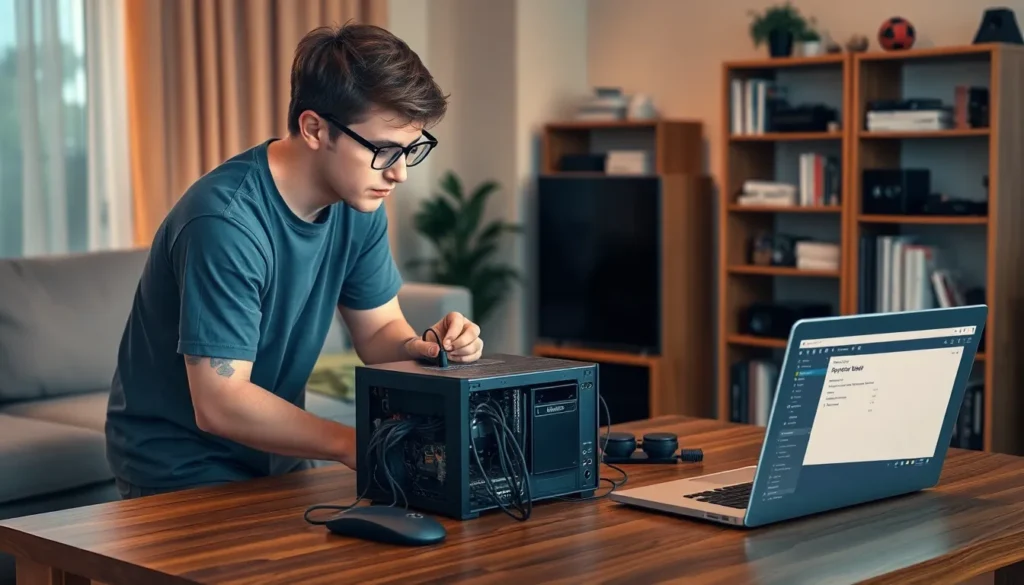In today’s digital age, everyone wants their own slice of the tech pie, and what better way to do that than with a home server? Imagine having your own personal cloud, media library, and even a fortress for your gaming adventures—all under one roof. It’s like having a mini data center in your living room, minus the lab coats and questionable beards.
Table of Contents
ToggleOverview of Home Server Setup
Setting up a home server involves several key components and considerations. Users should select a suitable machine, such as an old PC, dedicated server, or a NAS (Network Attached Storage) device. Choosing the right hardware depends on its intended use, like file storage or media streaming.
Storage capacity plays a crucial role in performance. It’s important to calculate the expected storage requirements based on the types of files users will manage. Data redundancy options, such as RAID (Redundant Array of Independent Disks), enhance reliability and safeguard against data loss.
Networking is a fundamental aspect. Connecting the server to the home network allows multiple devices to access data seamlessly. Using a wired connection often ensures better stability and speed compared to Wi-Fi, essential for tasks like streaming high-definition videos.
Software installation follows hardware setup. Operating systems designed for servers, like Ubuntu Server or Windows Server, provide the necessary tools. Users can enhance functionality with applications tailored for media libraries, file sharing, or backup solutions.
Security measures must not be overlooked. Implementing strong passwords, enabling firewalls, and utilizing VPNs (Virtual Private Networks) help protect sensitive information. Regular updates also enhance security and performance, keeping the server running smoothly.
Documentation of the setup process aids future adjustments. Users can benefit from creating notes on configurations, installed applications, and any troubleshooting steps taken. This information proves invaluable for maintenance and upgrades.
Understanding these essential aspects streamlines the home server setup process, ensuring efficiency and effectiveness for various tasks.
Benefits of a Home Server

Home servers provide numerous advantages, simplifying digital life at home. They enhance the functionality of various applications and systems tailored to individual needs.
Centralized Storage
Centralized storage offers easy access to files across devices. Multiple users can share data seamlessly without clutter on personal devices. With a home server, backups become more efficient, reducing the risk of data loss. RAID configurations boost storage reliability by allowing multiple drives to work together, ensuring data safety. Structured organization of files leads to faster retrieval and less time spent searching for important documents. The flexibility to expand storage options makes it easy to accommodate growing data needs.
Media Streaming
Media streaming becomes effortless with a home server. Individuals can store music, movies, and TV shows in one location for immediate access. This setup supports multiple users watching different content simultaneously without interruption. Downloading 4K videos or large files remains feasible due to ample storage space. Various media server applications enhance the experience by offering user-friendly interfaces and recommendations based on viewing habits. Personal libraries make it simple to catalogue and manage extensive collections of media.
Home Automation
Home servers streamline home automation, controlling various smart devices from a central hub. Integration of smart home systems allows for superior coordination between devices. Users can customize settings, creating efficient routines that meet household needs. A home server can act as a secure gateway, ensuring that automated devices communicate effectively with minimal exposure to security risks. Strengthened control over security systems and lighting contributes to energy efficiency and convenience. Managing connected devices from one location simplifies the user experience, fostering greater interaction with technology.
Choosing the Right Hardware
Choosing the right hardware is crucial for an effective home server setup. Different types serve specific purposes, allowing for optimizations based on user needs.
Server Types
Home server options include old PCs, dedicated servers, and NAS devices. Old PCs can be repurposed, making them cost-effective for general tasks. Dedicated servers offer higher performance and reliability, suitable for heavy usage, such as gaming or media streaming. NAS devices excel in data storage and redundancy, often integrating seamlessly with various operating systems to centralize file management. Each type presents unique advantages, catering to diverse requirements from simple file sharing to complex media libraries.
Recommended Components
Essential components for a home server include a powerful CPU, ample RAM, and sufficient storage. A CPU with multiple cores enhances processing speed, supporting various applications efficiently. For RAM, 8GB or more ensures smooth multitasking and responsiveness. Storage options could involve SSDs for speed or HDDs for larger capacity. Additionally, using RAID configurations boosts data protection, allowing for recovery in case of drive failure. Network interface cards also play a significant role, with gigabit Ethernet recommended for stable wired connections essential for streaming and file transfers.
Software Options for Home Servers
Selecting suitable software significantly enhances the functionality of a home server. Various options exist, tailored to different user needs and preferences.
Operating Systems
Numerous operating systems cater to home server setups. Ubuntu Server remains a popular choice due to its user-friendly interface and extensive community support. FreeNAS shines for its focus on network-attached storage, providing robust capabilities for data management. Windows Server offers flexibility and compatibility, making it ideal for users familiar with Microsoft ecosystems. Each OS presents unique features, allowing users to choose based on their specific requirements.
Applications for Management
Key applications streamline server management effectively. Plex serves as a media server, enabling seamless streaming of movies and music across devices. Nextcloud facilitates file sharing and synchronization, similar to cloud storage services but hosted personally. OpenMediaVault provides an intuitive interface for managing storage, user permissions, and plugins. Backup solutions, like Duplicati, automate data protection, ensuring users securely store important files. Utilizing these applications significantly enhances the experience of managing a home server, making tasks efficient and straightforward.
Configuration and Setup Process
Setting up a home server involves several key steps, ensuring smooth functionality. Start with the physical components, then focus on network settings for optimal performance.
Physical Setup
Select a suitable location for the server to avoid overheating and ensure adequate airflow. Place the server on a stable surface, preferably away from dust and direct sunlight. Check power supply options; use a reliable surge protector to safeguard against electrical issues. Connecting peripheral devices, such as a monitor or keyboard, may help during initial setup. Opt for efficient cooling solutions like fans if operating in warmer environments. Ensure all cables are organized and labeled for easier troubleshooting later. Room temperature should be monitored regularly for optimal hardware performance.
Network Configuration
Establish a strong wired connection for stable network speed. Configure the router settings to support port forwarding, allowing outside access to the server when necessary. Assign a static IP address to maintain consistency; this prevents future connectivity issues. Enabling Quality of Service (QoS) settings helps prioritize server traffic for smoother streaming experiences. Ensure the network has strong passwords to enhance security. Regularly check for firmware updates on your router, as these updates can improve performance and security. Consider using a VPN for added privacy when accessing the server remotely.
Maintenance and Security
Maintaining and securing a home server ensures optimal performance and protects sensitive data. Regular attention to updates and backup solutions is crucial.
Regular Updates
Keeping software updated strengthens security and enhances functionality. Operating systems for home servers typically receive patches to fix vulnerabilities. Additionally, applications like Plex or Nextcloud can benefit from newer features, improving user experience. Schedule automatic updates whenever possible to minimize manual tasks. Some users prefer checking for updates weekly to ensure everything runs smoothly. Staying informed about the latest releases provides insights into critical updates, promoting a proactive approach to server management.
Backup Solutions
Implementing reliable backup solutions safeguards against data loss. Regularly backing up essential files helps prevent devastating losses from hardware failures. Establish a routine for backing up data, such as daily or weekly schedules depending on usage. Both local and cloud-based backup options offer flexibility. Local backups on external drives provide immediate access, while cloud backups offer off-site security. Redundancy in backup solutions, such as using both methods, ensures maximum protection. Adopting tools like Acronis or rsync can automate the backup process and simplify management.
Setting up a home server opens up a world of possibilities for personal data management and entertainment. With the right hardware and software, individuals can create a customized solution that meets their specific needs. The ability to centralize storage and streamline media access enhances convenience and efficiency.
Security and maintenance are crucial for a successful home server experience. Regular updates and backups ensure data integrity and protection from potential threats. By taking the time to configure the setup properly and implementing best practices, users can enjoy the benefits of a home server for years to come. Embracing this technology not only simplifies digital life but also empowers users to take control of their data and devices.













